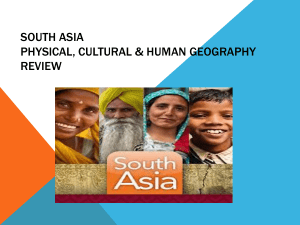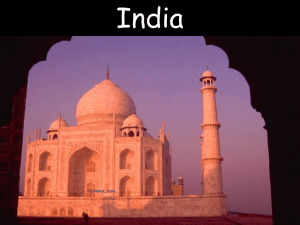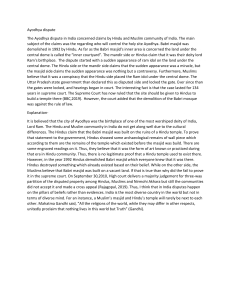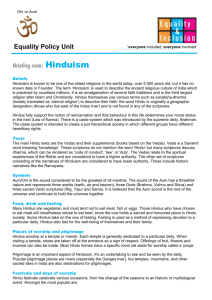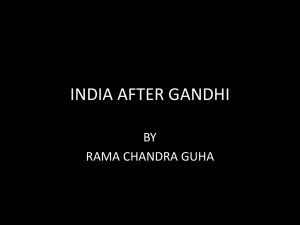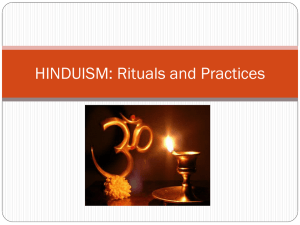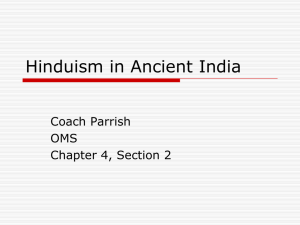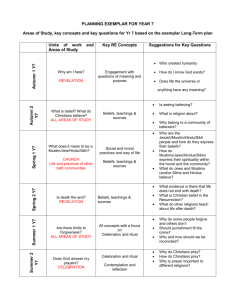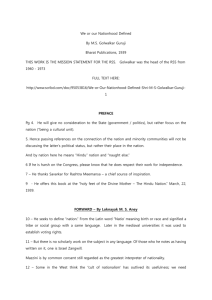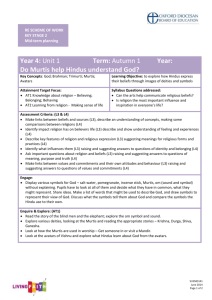Escaping the Corner in Kashmir - International Center for Religion
advertisement
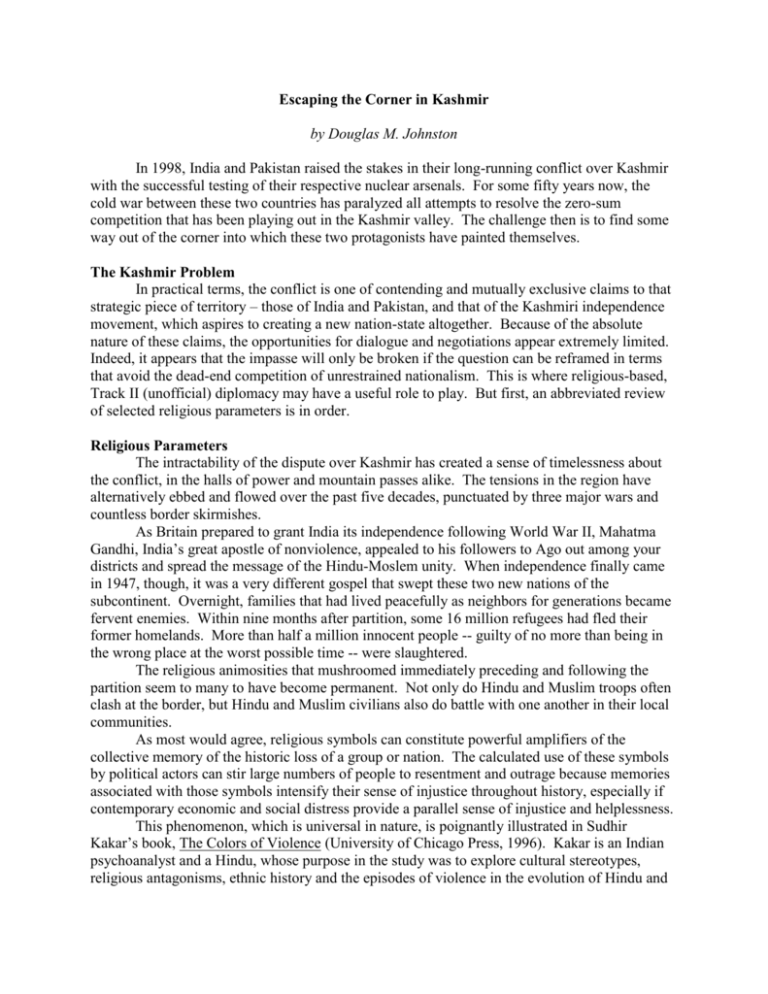
Escaping the Corner in Kashmir by Douglas M. Johnston In 1998, India and Pakistan raised the stakes in their long-running conflict over Kashmir with the successful testing of their respective nuclear arsenals. For some fifty years now, the cold war between these two countries has paralyzed all attempts to resolve the zero-sum competition that has been playing out in the Kashmir valley. The challenge then is to find some way out of the corner into which these two protagonists have painted themselves. The Kashmir Problem In practical terms, the conflict is one of contending and mutually exclusive claims to that strategic piece of territory – those of India and Pakistan, and that of the Kashmiri independence movement, which aspires to creating a new nation-state altogether. Because of the absolute nature of these claims, the opportunities for dialogue and negotiations appear extremely limited. Indeed, it appears that the impasse will only be broken if the question can be reframed in terms that avoid the dead-end competition of unrestrained nationalism. This is where religious-based, Track II (unofficial) diplomacy may have a useful role to play. But first, an abbreviated review of selected religious parameters is in order. Religious Parameters The intractability of the dispute over Kashmir has created a sense of timelessness about the conflict, in the halls of power and mountain passes alike. The tensions in the region have alternatively ebbed and flowed over the past five decades, punctuated by three major wars and countless border skirmishes. As Britain prepared to grant India its independence following World War II, Mahatma Gandhi, India’s great apostle of nonviolence, appealed to his followers to Ago out among your districts and spread the message of the Hindu-Moslem unity. When independence finally came in 1947, though, it was a very different gospel that swept these two new nations of the subcontinent. Overnight, families that had lived peacefully as neighbors for generations became fervent enemies. Within nine months after partition, some 16 million refugees had fled their former homelands. More than half a million innocent people -- guilty of no more than being in the wrong place at the worst possible time -- were slaughtered. The religious animosities that mushroomed immediately preceding and following the partition seem to many to have become permanent. Not only do Hindu and Muslim troops often clash at the border, but Hindu and Muslim civilians also do battle with one another in their local communities. As most would agree, religious symbols can constitute powerful amplifiers of the collective memory of the historic loss of a group or nation. The calculated use of these symbols by political actors can stir large numbers of people to resentment and outrage because memories associated with those symbols intensify their sense of injustice throughout history, especially if contemporary economic and social distress provide a parallel sense of injustice and helplessness. This phenomenon, which is universal in nature, is poignantly illustrated in Sudhir Kakar’s book, The Colors of Violence (University of Chicago Press, 1996). Kakar is an Indian psychoanalyst and a Hindu, whose purpose in the study was to explore cultural stereotypes, religious antagonisms, ethnic history and the episodes of violence in the evolution of Hindu and Muslim identities. The central case study in the book deals with the Hindu-Muslim riots in Hyderabad in 1990. The author relates that the countdown for the riots began when the then-president of the BJP, L. K. Advani, started a chariot pilgrimage from the Hindu temple of Somnath on the west coast to Ayodhya in the north. Somnath had been the site of one of the more magnificent temples in India. But in the eleventh century, Sultan Mahmud of Ghazni in Central Asia destroyed the temple on one of his periodic destructive sweeps through India, killing some 50,000 Hindus according to nationalist historians -- hundreds of thousands according to legend. Mahmud was famous as a destroyer of temples and a scourge of the Hindus. Mr. Advani’s purpose was to make the 6000 mile, 30 day journey and then construct a temple to the god Rama at his birth-site. His mission would necessarily involve destruction of the Babri mosque on that same site, just as Mahmud had destroyed the temple at Somnath -- an act long interpreted by Hindus as the greatest symbol of their defeat and humiliation at the hands of Muslims. Thus Mr. Advani’s purpose was to avenge Mahmud’s act of some nine centuries earlier and to restore the dignity and self-esteem of India’s Hindus by destroying the mosque and rebuilding Rama’s temple. It would be hard to find a more literal use of symbols for political purposes than those associated with this pilgrimage, which was stopped by the authorities before Mr. Advani could get to Ayodhya. The chariot that Mr. Advani constructed was a white Toyota van on the front of which had been painted a lotus, symbol of the BJP and a figure with many godly associations in Indian culture. The chariot was also associated with legends of mythical heroes going to war in the struggle of good versus evil. Accordingly, Hindus showered the chariot with flower petals and many said prayers and burned incense. Along the way, there were numerous incidents of HinduMuslim violence in the wake of the chariot’s visit to various villages. Finally, in December 1992, a crowd of some 100,000 Hindus attacked the Babri mosque and destroyed it, setting off another chain of communal violence all across India. This thus became yet another case of historic loss, with an accompanying sense of victimhood -- really a competition of victimhoods, symbolized most recently by the exchange of competing nuclear tests. While there are clearly no easy alternatives for reconciling the deep differences over Kashmir, one could envision the possibility of progress if both sides could see their way clear to take an honest walk through their history, with an eye toward understanding the sense of loss and injustice felt by the other party down through the centuries. Each side would have to acknowledge moral responsibility, in retrospect, for injustices that their own people have committed in the past. In the process, Hindus and Muslims should capitalize on the universal human values that link all religions and faith systems and that recognize each human being as a creature of God. This is a complex and sensitive process that would need careful research and highly competent facilitation. But it is work that clearly needs to be done, lest the passions that have led to war in the past lead to something far more disastrous in today’s nuclear context. This challenge may be more manageable than might first appear to be the case. For example, there are warrants for peacemaking and conflict resolution in each religion’s theology that can be brought to bear. In Hinduism’s theological attitude toward other faiths, one finds strong strains of tolerance and absorption. This is aptly illustrated in the admonition of the famous Hindu scholar, Keshub Chunder Sen in the mid-1800s: “How the Hindu absorbs the Christian; how the Christian assimilates the Hindu! Cultivate this communion, my brethren, and continually absorb all that is good and noble in each other. Do not hate, do not exclude others, as the sectarians do, but include and absorb all humanity and all truth.” While the quote deals with Hinduism and Christianity, the same logic applies toward Islam or any other religion. Over the centuries, Hindus have displayed a remarkable capacity for assimilating aspects of other faith traditions into their own religious framework. In Islam, the Qur’an specifically states that there is to be no compulsion in religion. It also portrays religious diversity not as an accident, but as something willed by God: “If God had willed, he would have made you one nation. But He did not do so, that He may try you in what has come to you [as guidance]. So, compete with one another in good works; Unto God shall you return; altogether; and He will tell you the Truth about what you have been disputing.” This strong and very specific endorsement of religious pluralism is, of course, ignored by most militants. As with the other major world religions, both Hinduism and Islam include their own version of the Golden Rule and include more acknowledgment of the common moral wisdom of the human race. Thus, the fundamental challenge that confronts peacemakers in the difficult years ahead is one of working past the external veneer of nationalism that concurrently burdens most religious traditions, and to get back to the basics of what these religions are fundamentally about, that being neighborly concern and the betterment of humanity. The notion of using religion to reconcile differences rather than to exacerbate them may sound novel, but it is not new. This aspect of religion has been captured in a book published in 1994 by Oxford University Press entitled Religion, the Missing Dimension of Statecraft. This book, which has received widespread acclaim in such publications as Foreign Affairs, The New York Times, The Washington Post, The International Herald Tribune, The Financial Times of London, and numerous others, is now in its eleventh printing and going into its third foreign language translation. Further, it is required reading at the U.S. Foreign Service Institute and is being used as a course text in numerous colleges and universities around the world. Thus, there is increasing awareness that the time has come for new and unconventional approaches. Perhaps it is time to consider a sequenced approach to peacemaking in Kashmir, one in which official diplomacy reinforces and builds upon the trust that religious third parties can sometimes bring to such situations. With all other approaches having failed, the Washington-based International Center for Religion & Diplomacy has launched such an effort with two specific goals in mind: (1) establishing a lasting peace, and (2) providing an effective framework for rebuilding civil society. Only time will tell if such an approach can work, but it is clear that the stakes are too high not to try.
